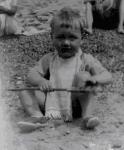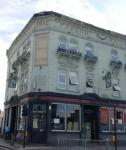Mabel Victoria Day (1897 - 1943)
22 July 1897 – 27 November 1943
Mabel Victoria DAY was the fourth child of Charles J. DAY and Emily Rebecca MORRIS. Born in July 1897 at 53 Clever Road, Custom House, West Ham, she spent her entire life in London. Still scarcely more than a girl when WW1 broke out, she died, aged 46, in November 1943 as an indirect result of WW2. Her only child, George ALDIS, was born in 1935 when Mabel was 38, the father being George Mafeking ALDIS, a fireman. Son George was a young evacuee at the start of WW2 but returned to live with his parents in war-torn London until Mabel’s death from pneumonia in 1943.
It is difficult not to form the impression that Mabel’s was a pretty brutal existence - short, hard, and stressful. What her home life was like, and whether she was happy as a child, is unknown; father Charles was a dock labourer, and by 1901 he and Emily had a family of six ranging from Daisy, aged 11, to Jesse at 11 months. There is evidence, however, that Mabel was close to older sister Daisy and also to younger sister Millicent Rhoda (‘Millie’) and that she corresponded with brother William Victor (‘Will’).
A strong sense of community existed in Dockland and amongst docklanders certainly until the great watershed of 1939, by which time Emily was dead and the family had dispersed. First-hand accounts of Dockland life are hard to come by, but one such account is to be found in a chapter by Eve Hostettler from a compilation entitled Dockland - An Illustrated Historical Survey of life and work in east London. Eve Hostettler’s A dockland community - the Isle of Dogs is based on work done for the Island History Project by Thomas J. Cole and for a Ph.D thesis, Life and labor in the Isle of Dogs: The Origins and Evolution of an East London Working-Class Community 1800-1980.
Though referring specifically to the Isle of Dogs, the broad outline holds true, in general, for life in the East end of London. During the first four decades of the twentieth century, a time recalled with affection by Eastenders, Dockland was solidly working-class with many of the characteristics traditionally associated with such communities: a strong sense of local identity and a stable population bound together by friendship, marriage and shared experience. Children attended local schools, almost all first jobs were local, and people tended to marry where they had grown up. Local work and family connections encouraged newly-weds to find homes locally, and family ties were strong and valued. Family members were part of an intricate network of friends and relations, both close and distant. Neighbours, relations and friends all shared the same environment which was noisy, with the sound of industry and the working docks, and polluted with chemical fumes and the dust of manufacture. Families lived in privately rented nineteenth-century terraces, some with basements, most overcrowded and in multiple occupation, shared with relatives, with another family, or with lodgers. Some new housing was built in the 1920s and 1930s providing bathrooms, electric light and more space. Privacy was less, communal life greater. The street and other outdoor places were used for social intercourse because ‘indoors’ was crowded and hot in summer; so the street was the place to play, to party, to chat neighbourly and to watch the world go by. Streets were served by local shops and by street markets.
Cultural life centred around pubs, the music hall, chapels and mission halls. Football was the most popular sport, creating dozens of amateur clubs. Fighting was a favourite pastime, and people kept dogs, rabbits, caged birds and racing pigeons; they cultivated flowers and vegetables in their gardens and allotments. There was a clear notion of ‘men’s work’ and women’s work’, and the ideal preference was for women not to work outside the home. There were accepted guidelines for behaviour in childhood, work, courtship, marriage and raising a family, but also a tolerance for divergences from the accepted norm.
Poltically, Dockland was solidly Labour, most occupations had their unions and there was a degree of shared leisure amongst those who worked together. The comradeship of work - sharing the same trade - formed close bonds within and between families. Whether employment was in skilled or unskilled occupations, a degree of poverty was common. Many workers were in low-paid jobs, especially women in food-processing factories; lay-offs, short-time, redundancies, enforced unemployment through sickness or accident were part and parcel of the daily fare. Dockers, in particular, suffered through the notoriously casual nature of their trade. The common insecurity and close-knit life-style created many opportunities for mutual help and co-operation. Housewives supported each other in sickness and childbirth, they shared food and passed on clothes. Such acts of kindness and neighbourliness did not eliminate poverty, but they made it easier to bear.
During this period there was no major change in the physical environment which had been shaped by earlier industrial development. Street lay-out, shops, pubs, work places looked much the same to the adult of the 1930s as they had done to the child of Edwardian times. There were changes, of course - the First World War, the coming of the motor car and cinema, some new housing - but these only served to emphasize the apparent stability of local conditions. Yet it was not a community of any long-standing or deeply established tradition, having emerged only just before the turn of the century after almost a hundred years of growth and change. The new century brought the agony of the Great War, the long grind of the Great Depression, years of damp housing, poor health and the constant struggle to make ends meet. For all that, life in that community provided its children with happy memories and a clear set of values against which to measure succeeding generations.





